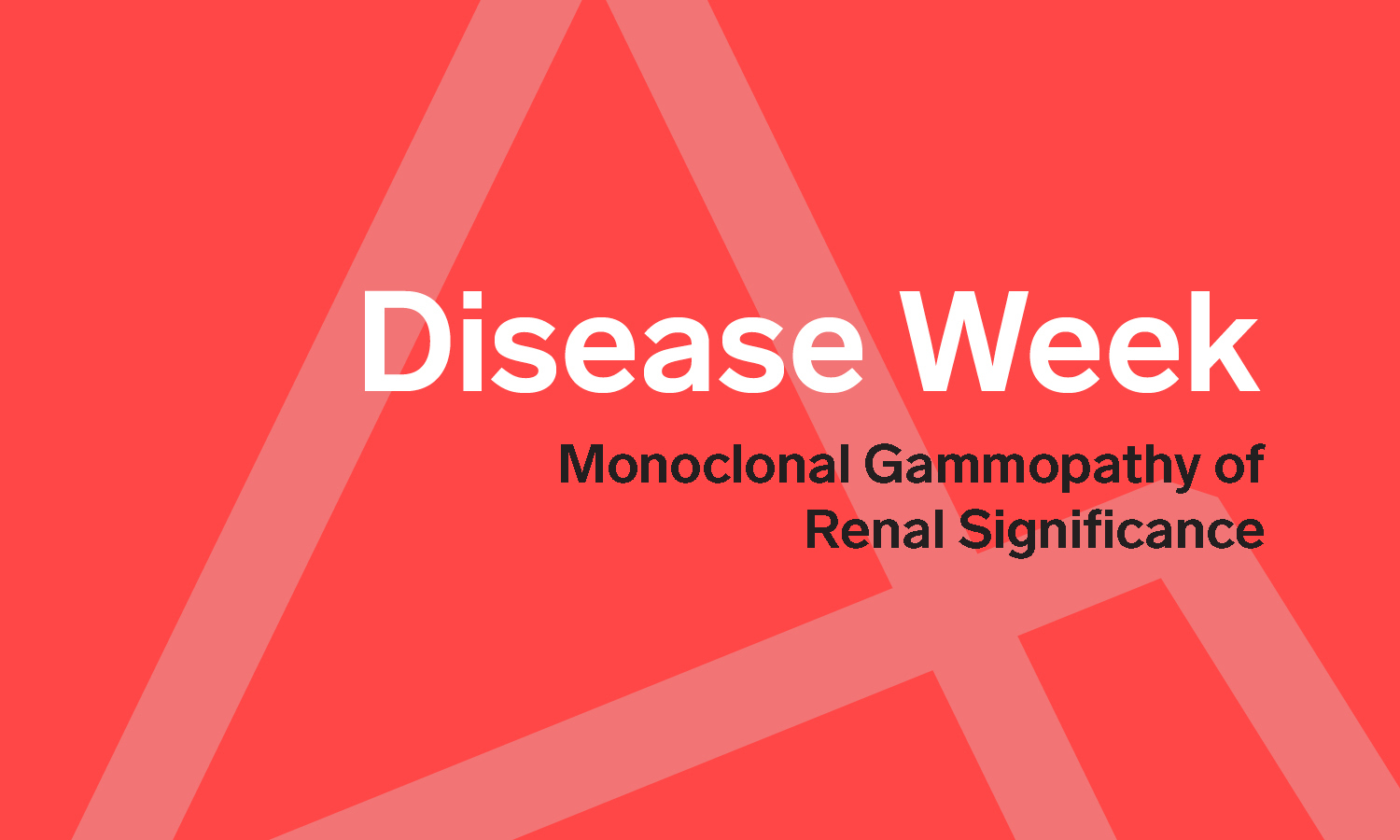Disease Week: Monoclonal Gammopathy of Renal Significance
Summary:
Renal disease caused by parenchymal deposition of circulating monoclonal immunoglobulins (mIg) is a well established phenomenon. Light chain cast nephropathy, light chain deposition disease and AL amyloidosis are probably the best known entities; nevertheless, the list also includes a number of less common and recently described entities, some of which are still poorly understood. These disorders may be seen in the setting of either a B-cell or plasma cell proliferative disorder with production of a mIg. When these proliferative disorders represent an overtly malignant disease (e.g. multiple myeloma, Waldenström macroglobulinemia, high-grade lymphoma, etc), patients are treated according to established disease-specific protocols. On the other hand, patients with premalignant hematologic conditions or diseases that otherwise do not meet hematologic criteria for specific treatment (e.g. MGUS, smoldering myeloma, smoldering Waldenström macroglobulinemia, low-grade lymphoma, etc), were historically managed conservatively. This led to the observation that these patients frequently progressed to end-stage renal disease (ESRD) with recurrence of the disease in the allograft. In 2012, the concept of monoclonal gammopathy of renal significance (MGRS) was introduced, primarily to highlight the importance of clone-based treatment to preserve and improve renal function in these patients. While the concept remains the same, the definition of MGRS was updated in 2019 by the International Kidney and Monoclonal Gammopathy Research Group (IKMG):
“The term MGRS applies specifically to any B cell or plasma cell clonal lymphoproliferation with both of the following characteristics: 1) One or more kidney lesions that are related to the produced mIg; and 2) the underlying B cell or plasma cell clone does not cause tumor complications or meet any current hematological criteria for specific therapy”
MGRS-associated diseases or lesions are predominantly classified according to the characteristics and texture of the monoclonal deposits. Diseases with non-organized deposits include monoclonal immunoglobulin deposits disease (MIDD) and the frequently discussed entity proliferative glomerulonephritis with monoclonal immunoglobulin deposits (PGNMID). While the latter entity was originally described having exclusively monoclonal IgG deposits, it is now known that essentially identical cases may be seen with monoclonal IgA and IgM deposits. Other, previously described, polytypic entities can also have a monotypic counterpart that fits within the MGRS classification, such as membranous glomerulopathy, anti-GBM disease, and HSP. MIg may also form organized deposits in the form of fibrillar, microtubular or crystalline structures. The classic example of a disease with fibrillar deposits is immunoglobulin-related amyloidosis. Fibrillary glomerulopathy may occasionally be caused by monoclonal deposits as well. When monotypic light chain staining is seen in fibrillary glomerulopathy, it is recommended to perform immunofluorescence on the paraffin tissue after antigen retrieval to confirm the monotypic nature of the deposits. Type I and II cryoglobulinemic glomerulonephritis and immunotactoid glomerulopathy are diseases that often show microtubular deposits. Lastly, light chain proximal tubulopathy, crystal storing histiocytosis and crystaglobulin glomerulonephritis show crystalline deposits that are frequently “masked” by routine immunofluorescence. Interestingly, there are examples of renal diseases caused by mIg, without actual parenchymal deposition of the abnormal immunoglobulin. Such is the case in some types of C3 glomerulopathy (C3G) and thrombotic microangiopathy (TMA). While TMA in the setting of mIg is poorly understood, we now know that C3G, at least in some patients, is caused by anti-complement activity of the mIg. It is worth noting that light chain cast nephropathy (LCCN) is not included in this list of MGRS-associated diseases given as it is considered a myeloma-defining event by the International Myeloma Working Group.
It is of utmost importance for the pathologist to be familiar with these disorders and to have a high level of suspicion when dealing with biopsies from patients with monoclonal gammopathy. Correct diagnosis and identification of the monotypic/monoclonal nature of the disease will have a significant impact on the management, treatment, and prognosis or patients with MGRS.
References:
Leung, N., F. Bridoux, V. Batuman, et al. (2019). “The evaluation of monoclonal gammopathy of renal significance: a consensus report of the International Kidney and Monoclonal Gammopathy Research Group.” Nat Rev Nephrol 15(1): 45-59.
Leung, N., F. Bridoux, C. A. Hutchison, et al. (2012). “Monoclonal gammopathy of renal significance: when MGUS is no longer undetermined or insignificant.” Blood 120(22): 4292-4295.
Quick note: This post is to be used for informational purposes only and does not constitute medical or health advice. Each person should consult their own doctor with respect to matters referenced. Arkana Laboratories assumes no liability for actions taken in reliance upon the information contained herein.



